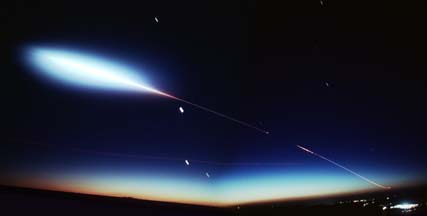
Pegasus/Wide-field Infra Red Explorer launch, March 4, 1997 |
(Download a higher resolution picture by clicking on any
picture below.) 
 A Pegasus rocket was launched from Stargazer,
the Orbital Sciences L-1011, at 6:56 P.M. on March 4, 1999. Its
payload was the Wide-field Infra Red Explorer (WIRE) satellite.
The booster climbed out of the earth's shadow during the second
stage engine burn in this time exposure. It is framed by the
planets Mercury, Jupiter, Venus, and Saturn. The bright spot at
the lower right is the lights of the town of Buellton in the
Santa Ynez Valley.
A Pegasus rocket was launched from Stargazer,
the Orbital Sciences L-1011, at 6:56 P.M. on March 4, 1999. Its
payload was the Wide-field Infra Red Explorer (WIRE) satellite.
The booster climbed out of the earth's shadow during the second
stage engine burn in this time exposure. It is framed by the
planets Mercury, Jupiter, Venus, and Saturn. The bright spot at
the lower right is the lights of the town of Buellton in the
Santa Ynez Valley.
The WIRE satellite was designed to study galaxies at infrared wavelengths. It was expected to study 50,000 galaxies, particularly starburst galaxies in the early universe. Unfortunately, the WIRE satellite suffered a system failure and its supply of hydrogen coolant has already been depleted.
From top to bottom, the planets Saturn, Venus, Jupiter, and Mercury are lined up in the background. It's about 100,000,000 miles to Venus and Mercury. They are both near their maximum elongation from the sun. Jupiter is 600,000,000 miles away on the far side of the sun, and Saturn is out there 900,000,000 miles.
This image was assembled from two frames of Kodachrome 64. I shot it with a pair of Pentax K-1000 cameras fitted with Tamron 28-mm f2.5 lenses wide open on Kodachrome 64. I spliced the two images together with Adobe Photoshop.
 The exhaust cloud glowed quite brightly in the
sunlight immediately after launch.
The exhaust cloud glowed quite brightly in the
sunlight immediately after launch.
 As the outer parts of the expanding exhaust
cloud faded, the main exhaust trail took on the appearance of a
comet with a green coma and a red tail.
As the outer parts of the expanding exhaust
cloud faded, the main exhaust trail took on the appearance of a
comet with a green coma and a red tail.
 The round cloud at the end of the exhaust trail
turned bluer as it faded.
The round cloud at the end of the exhaust trail
turned bluer as it faded.
 Eventually the blue cloud was all that remained
to be seen, kind of like the smile on a cheshire cat.
Eventually the blue cloud was all that remained
to be seen, kind of like the smile on a cheshire cat.
Go to home page of the Goleta Air and Space Museum.
I am always interested in more information about these launches. Send a note to Brian if you have something to add.
The home page of the ![]() 30th Space Wing
30th Space Wing
For national and international space coverage visit SPACE.com
Those interested in rocket launches and amateur radio should check out the Rawhide Space Page